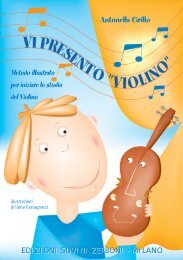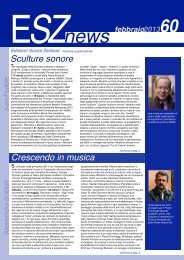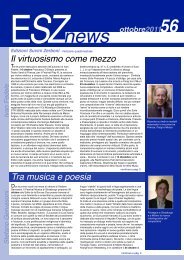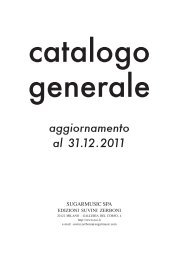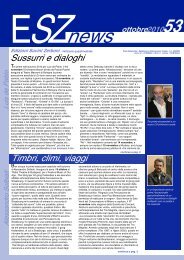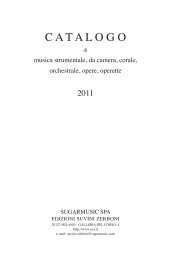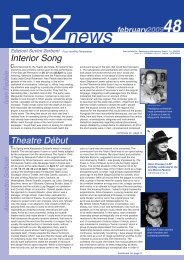Timbral Spaces Sound Labyrinths - Edizioni Suvini Zerboni
Timbral Spaces Sound Labyrinths - Edizioni Suvini Zerboni
Timbral Spaces Sound Labyrinths - Edizioni Suvini Zerboni
You also want an ePaper? Increase the reach of your titles
YUMPU automatically turns print PDFs into web optimized ePapers that Google loves.
Giorgio Colombo Taccani<br />
Solitary Voices<br />
The first performance of L’image oubliée<br />
for piano is scheduled for October 1 st at<br />
the Teatro di Marcello in Rome, during the<br />
Festival delle Nazioni; it will be played by<br />
Adele D’Aronzo, to whom the piece is<br />
dedicated. The composer explains: «To<br />
mark the 150 th anniversary of the birth of<br />
Claude Debussy I was asked to write this<br />
new short piece for piano which, with the<br />
greatest of respect, takes it starting point<br />
from the first two bars of Hommage à<br />
Rameau from Images. These become the<br />
structural basis of the entire work,<br />
expanding to cover the whole length, the<br />
basic material for countless local<br />
elaborations. Excluding a priori any direct<br />
stylistic reference and, even more so, any<br />
explicit quotation, a harmonic colour diatonically linked<br />
to the starting point is nevertheless often determined,<br />
within a piano writing that privileges resonance and<br />
liquidity». Restless White for flute will be premiered on<br />
October 4 in Wellington (New Zealand) by its<br />
prestigious dedicatee Roberto Fabbriciani, who will also<br />
give the piece its first Italian performance on November<br />
18 in the Auditorium Celesti in Desenzano during the 5 th<br />
Festival of the Ned Ensemble. The composer tells us:<br />
«As can be deduced from the title, the work is<br />
characterized by a constantly anxious and restless<br />
pace; there is no melodic-cantabile tendency, the<br />
course of the piece being guided by minimal ideas<br />
repeated with a regularity that is almost obsessive and<br />
in this prospective highly expressive; the timbral<br />
resources, whether traditional or of more recent origin,<br />
are used with decision in the flute writing. The narrative<br />
course therefore does not follow a straight line, even<br />
though its climax comes towards the end, but rather<br />
has a spiral tendency, within which the elements turn<br />
without any real evolution of the discourse. Beneath it<br />
all, to give the work coherence, is the kaleidoscopic<br />
presence of a short fragment of seven notes, a<br />
fundamental element throughout the work». On 19<br />
October, during the second edition of the Festival Play<br />
It!, at the Teatro Verdi in Florence, the first performance<br />
will be given of Dura roccia for bassoon and string<br />
orchestra; the soloist will be Paolo Carlini, dedicatee of<br />
the piece along with the Orchestra della Toscana,<br />
conducted on this occasion by Francesco Lanzillotta.<br />
Colombo Taccani says: «Dura roccia represents a new<br />
step in my long fascination with low instruments. The<br />
title (think of it in English…) refers to the roughness and<br />
aggression that characterize much of the piece. Two<br />
contrasting situations are developed in alternation: the<br />
first is based on the cadential and violent mood of the<br />
solo part, which contrasts with the resonant and<br />
tendentially lyrical nature – though always undermined<br />
by more or less subterraneous drives towards<br />
disgregation – of the second. This goes on for the<br />
whole length of the piece, in which the strings are<br />
always ready to expand and exploit what the bassoon<br />
has proposed. The closing bars feature the paradoxical<br />
dwelling of the soloist on the final high note, below<br />
which the strings offer their last utterances, now unable<br />
Maurilio Cacciatore<br />
From October 6 to 13 the Biennale di Venezia, 56 th<br />
Festival Internazionale di Musica Contemporanea, will<br />
host for the first time in Italy the interactive<br />
electroacoustic installation Apparaître, disparaître, se<br />
cacher, realized by Simone Conforti. Impuro minimo for<br />
violin, cello and piano can be heard on October 25 at<br />
the Festival Spazio Musica in Cagliari, during a concert<br />
in collaboration with the New Made Ensemble and ESZ,<br />
featuring the New Made Ensemble: Raffaello Negri,<br />
to force the path elsewhere». A very<br />
unusual instrumentation can be found in<br />
Lybra, which will be premiered on<br />
October 20 at the Palazzo Chigi in<br />
Ariccia (Rome) by Jessica Horsley: the<br />
work, commissioned by the Ars Braemia<br />
(Switzerland), is in fact written for<br />
baryton, an instrument similar to the<br />
viola da gamba and characterized by the<br />
presence of a variable number of strings<br />
on the back of the instrument, which, as<br />
well as vibrating sympathetically, can<br />
also be plucked by the thumb of the left<br />
hand; many works for this instrument,<br />
much loved by prince Esterházy but<br />
soon fallen into disuse, were written by<br />
Haydn and Tomasini. The composer<br />
explains: «Taking its cursory inspiration from Haydn, the<br />
course of Lybra is guided by the constant return of<br />
certain main figures, especially chosen to highlight the<br />
surprising characteristics of the baryton; a decisive role<br />
is thus assumed by the broad arpeggios played on an<br />
almost regular basis at the start of the piece, and the<br />
falling figures shared between the front and back<br />
strings. Local digressions interrupt the path, in a climate<br />
that is constantly mobile and vital». Recent<br />
performances of the composer’s works include: Soleil<br />
levant, from the Due pezzi for bass flute, played by<br />
Laura Chislett-Jones at Sydney Grammar School on<br />
June 2; then on June 16, at the Hochschule für Musik<br />
in Basel, Stojan Krkuleski on the clarinet, Elia<br />
Portabales on viola and Gaelle Levevre on cello played<br />
Eco; on July 1 st Avvoltoi for voice and four instruments<br />
was performed during the Festival of Bellagio and Lake<br />
Como by Akiko Kozato and the New Made Ensemble<br />
directed by Alessandro Calcagnile; during the same<br />
Festival, on September 9, a performance was given of<br />
Nox, Tellus for solo voice, again by Akiko Kozato;<br />
L’àgnili for voice and piano on two poems in Sardinian<br />
by Pompeo Calvia was performed on July 12 during<br />
the series Suono Immagine at the Conservatory in<br />
Milan; on September 5 Antilia for piccolo and guitar<br />
was played by the Antilia Duo in the context of the<br />
project Irid. Visual Concert, in the Auditorium Lattuada<br />
in Milan; Eco celata entro braci ardenti for flute and<br />
harpsichord was played on September 7 by the Duo<br />
Novecembalo in Porretta Terme, during the Festival<br />
Nuovi Orizzonti Sonori; on September 23 at the Tokyo<br />
Opera City the instrumentalists of the Nomad Ensemble<br />
played Richiamo da lontano for flute and clarinet; on<br />
September 24, in the church of St. Martin-within-<br />
Ludgate in London, Laura Chislett-Jones and Thomas<br />
Jones played Luz for flute and violin. On October 25<br />
Avvoltoi for voice and four instruments on a poem by<br />
Simon Pederek will be performed at the Festival Spazio<br />
Musica in Cagliari by Akiko Kozato and the New Made<br />
Ensemble directed by Alessandro Calcagnile, during a<br />
concert in collaboration with the New Made Ensemble<br />
and ESZ. Finally, on October 27, the Duo Alterno will<br />
play L’àgnili for voice and piano at the Museo di Santa<br />
Caterina in Treviso during the Festival Finestre sul<br />
Novecento.<br />
violin, Guido Boselli, cello, and Rossella Spinosa,<br />
piano. Finally, on December 7 the Opéra de Lille will<br />
host Tamonontamo for amplified vocal quartet, 24 voice<br />
choir and live-electronics, with Adèle Carlier, soprano,<br />
Marie-Paule Bonnemason, contralto, Stephan Olry,<br />
tenor, Jean-Michel Durang, bass and Les Cris de Paris<br />
directed by Geoffroy Jourdain. The live electronics will<br />
be realized by Ircam.<br />
Three premieres for solo<br />
instruments, a fourth for<br />
soloist and orchestra<br />
Giacomo Manzoni<br />
On November 7 in the Auditorio<br />
Nacional de Música in Madrid,<br />
Fabián Panisello will conduct<br />
the Plural Ensemble in a<br />
performance of Musica notturna<br />
for five wind instruments, piano<br />
and percussion.<br />
Pagina da camera in prima<br />
assoluta, quasi un intermezzo<br />
11



